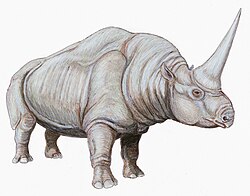Discovery and naming
In 1895, John Bell Hatcher described a partial cranial material from the Uinta Formation of Utah, YPM-PU 11242, as the holotype of a new species of brontothere. He tentatively included the taxon as a species of Diplacodon (D. emarginatum), but he noted that "should future discoveries show that there are hornless forms with same dental characters as Diplacodon", it would require a new genus name Protitanotherium. [2]
In a strict sense, Protitanotherium emarginatum is restricted to the type specimen, [3] though other authors have referred other specimens to this species. [1] The genus name is a portmanteau of the Latin word meaning "before" (pro) and Ancient Greek words meaning "giant" (titan) and "beast" (therion). [4] It was later accepted for use by other authors including Osborn (1908) who named a putative second species P. superbum (AMNH 2501) from the same locality, but this species was later suggested to be synonymous with P. emarginatum. [1]
It was once claimed that Sthenodectes australis (TMM 41723-3) described by Wilson (1977) from the Pruett Formation of Texas and some skull specimens from other formations (Uinta Formation, Wiggins Formation and Devil's Graveyard Formation) might represent a single taxon similar to P. emarginatum, [3] but Mihlbachler suggested that Sthenodectes australis is synonymous with P. emarginatum and redescribed the Wiggins Formation specimen (AMNH 117163), previously referred to as cf. Protitanotherium, as the holotype of Diplacodon gigan . [1] [5] Fragmentary brontothere specimens from the middle to late Eocene strata of North Korea were named as P. koreanicum by Takai (1939), but this species is now considered as a nomen dubium . [1]
This page is based on this
Wikipedia article Text is available under the
CC BY-SA 4.0 license; additional terms may apply.
Images, videos and audio are available under their respective licenses.










